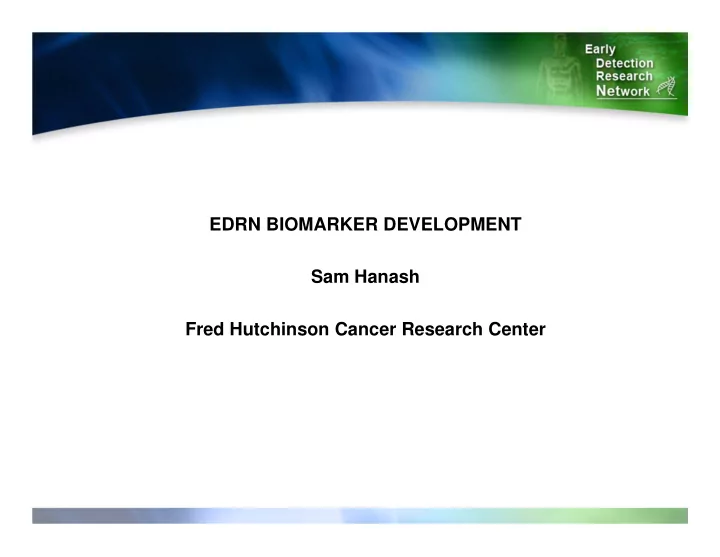

EDRN BIOMARKER DEVELOPMENT Sam Hanash Fred Hutchinson Cancer Research Center
CONTENTS 1- Two studies that progressed from discovery to blinded validation in a context of early detection 2- Collaborative work within and outside of EDRN Development laboratories 3- Leveraging resources outside of EDRN
Why so few biomarkers to date? - Developing biomarkers shares some of the same challenges as developing drugs - Requires a road map from discovery to validation for defined clinical applications ( Hanash et al Nature in press )
Autoantibodies as biomarkers for early cancer detection
Immune response to tumor antigens - Occurs early during tumor development: may allow early cancer detection - Is not limited to mutated proteins - May involve aberrantly expressed proteins eg oncofetal antigens - Epitopes may result from post-translational modifications eg glycosylation
ANTI-ANNEXINS I & II ANTIBODIES IN LUNG CANCER # subjects Annexin I Annexin II Antibody + Antibody + Lung Cancer 54 16 18 Adenocarcinoma 30 12 11 Squam cell carcinoma 18 3 4 Small cell carcinoma 4 1 2 Large cell carcinoma 2 0 1 Other cancer types 60 6 0 Other controls 61 0 0 Healthy subjects 51 0 0 Chronic lung disease 10 0 0
CARET Validation strategy Blinded validation study Approach: Protein microarrays Contents: Natural proteins derived from tumor cell line(s ) Samples: Collected ~1 yr prior to lung cancer dx from 100 cases and 100 matched controls Targets: Annexin, PGP9.5, 14-3-3 theta Data analysis: NCI EDRN Data Management Center
Identification of 14-3-3 theta as an antigen that induces a humoral response in lung cancer Sandra R. Pereira-Faca et al (Cancer Research ‘07)
Validation Phase 2 - Validate intended clinical application: Blood test in combination with CT scanning - Demonstrate increased specificity and sensitivity of CT scans when combined with an autoantibody marker panel for high risk subjects - Retrospective component - Prospective component
Pancreatic cancer markers from discovery in the mouse to blinded validation study in pre-diagnostic sera
Pancreatic cancer mouse model K-ras activation + Ink4a/Arf for pancreatic cancer R. DePinho and N. Bardeesy - Plasma from mice with early stage tumor and matched controls - Plasma from mice with advanced stage tumor and matched controls
Validation 54 potential biomarkers Available ELISA Available Abs- No Abs Serum analysis IHC, no ELISA Need to make to validate Abs
NHLBI-WHI Markers for early detection of colon Cancer 10 Academic NCI-EDRN Institutions
NHLBI-NCI-WHI-EDRN Collaborative study S. Hanash & R. Prentice Co-PIs 100 colon cancer cases that occurred 6 – 18 m following yr 3 blood draw + 100 matched controls 10 teams applied a variety of proteomics approaches to aliquots from the same blood draws All data compared and integrated Promising biomarkers to be validated in a second phase
Participating Institutions Fred Hutchinson Cancer Research Center Harvard Medical School R. Kucherlapati PNNL R. Smith Johns Hopkins University D, Chan Northeastern University W. Hancock University of Michigan A. Chinnaiyan Wayne State University M. Tainsky Eastern Virginia University J. Semmes Wistar Institute D. Speicher University of Pittsburgh W. Bigbee
Innovative nature of the study Discovery studies at the pre-clinical stage Reduced bias due to multi-institutional sample collection Reduced bias due to asymptomatic status of subjects at the time of blood draw Analysis of aliquots of the same samples by multiple investigators/platforms Sample blinding at the time of data collection Centralized integrated analysis of all data collected
Data Analysis Data processing: CPAS (M. McIntosh) Data management: EDRN DMCC (Z. Feng) Statistical Analysis: WHI (R. Prentice)
Findings A total of 2,343 high confidence protein groups were identified which corresponds to up to 2,876 distinct gene symbols (compared to HUPO PPP of 889 proteins identified). A total of 1,846 of these proteins were identified in at least two separate laboratories.
Summary of significance 65 proteins identified with quantitative values and P<.05 in one ore more labs (41 up, 24 down in pre-diagnostic specimen relative to matches controls). 11/65 proteins showed significance in more than one lab.
Phase 2 Validation of candidate markers using a second set of WHI subjects Further mining of the data for PTMs, Glycan modifications..
Leveraging non-EDRN resources NCI: Mouse Models, Glycomics Alliance, Nanotechnology Other NIH Institutes: HUPO PPP Cohorts: CARET, WHI, PLCO Foundations - Lustgarten: Pancreas - Labrecque: Lung - Avon: Breast - Canary: Lung, pancreas, ovary, prostate
CANARY FOUNDATION Stopping cancer early...the best possible investment Canary Lung Project MISSION: Early detection of lung cancer through a combination of imaging, sputum and/or blood based testing applicable to lung cancer among smokers as well as never smokers.
Recommend
More recommend